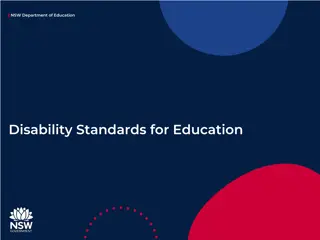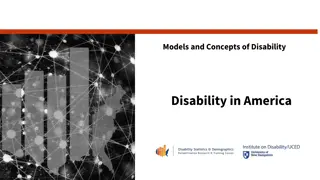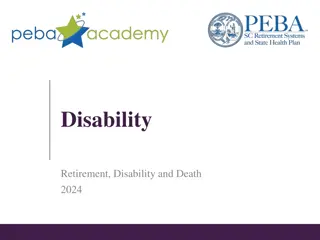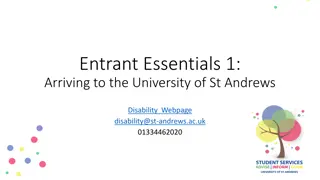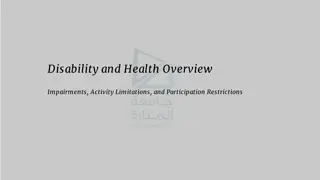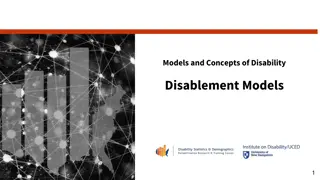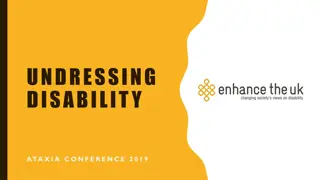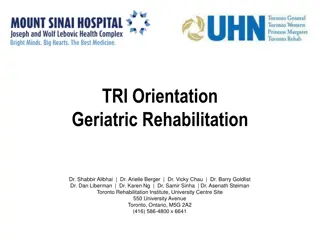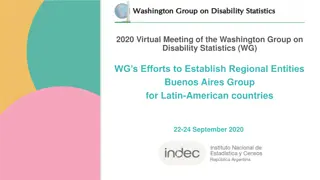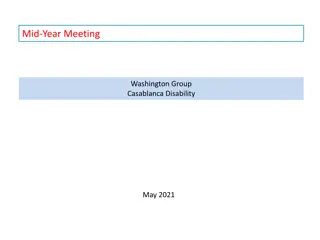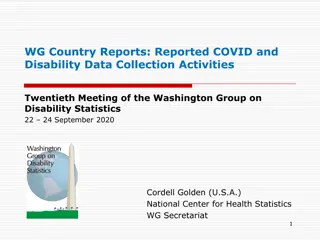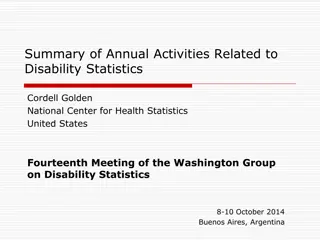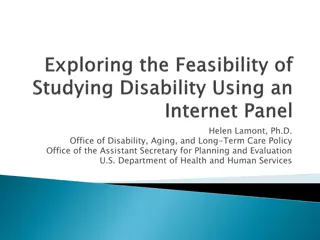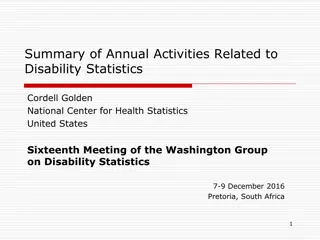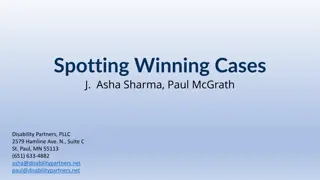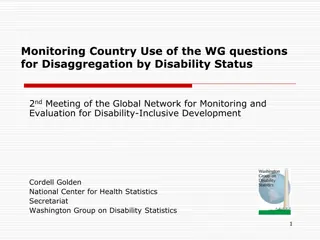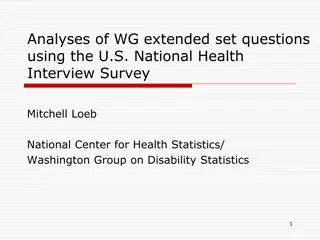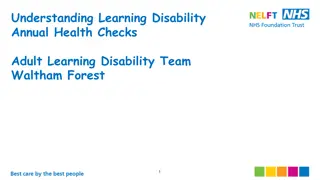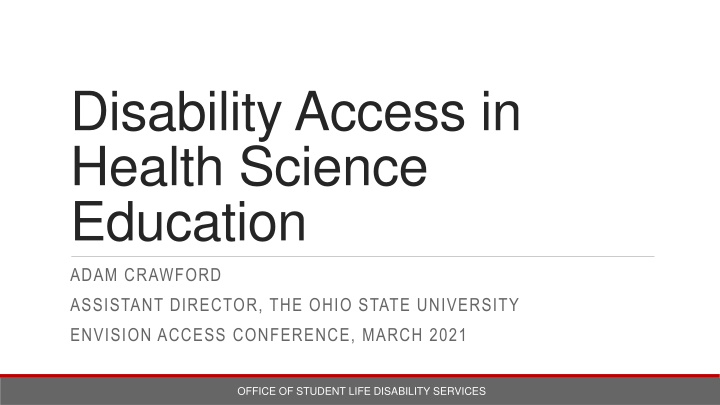
Enhancing Disability Access in Health Science Education
Explore strategies and resources for creating disability access in health science education, including knowledge building, discipline-specific accommodations, relationship development, and collaboration opportunities. Discover key terminology and valuable resources to promote equal access for students with disabilities in professional education settings.
Uploaded on | 4 Views
Download Presentation

Please find below an Image/Link to download the presentation.
The content on the website is provided AS IS for your information and personal use only. It may not be sold, licensed, or shared on other websites without obtaining consent from the author. If you encounter any issues during the download, it is possible that the publisher has removed the file from their server.
You are allowed to download the files provided on this website for personal or commercial use, subject to the condition that they are used lawfully. All files are the property of their respective owners.
The content on the website is provided AS IS for your information and personal use only. It may not be sold, licensed, or shared on other websites without obtaining consent from the author.
E N D
Presentation Transcript
Disability Access in Health Science Education ADAM CRAWFORD ASSISTANT DIRECTOR, THE OHIO STATE UNIVERSITY ENVISION ACCESS CONFERENCE, MARCH 2021 OFFICE OF STUDENT LIFE DISABILITY SERVICES
Agenda oReview four areas of focus in creating disability access in health science education: 1. growing your knowledge of the health sciences 2. understanding discipline-specific accommodations 3. developing effective relationships and processes 4. identifying areas for collaboration oQ&A OFFICE OF STUDENT LIFE DISABILITY SERVICES
Growing Your Knowledge of the Health Sciences FOCUS AREA #1 OFFICE OF STUDENT LIFE DISABILITY SERVICES
Equal Access for Student with Disabilities: The Guide for Health Science and Professional Education Lisa M. Meeks, Neera R. Jain, and Elisa P. Laird 2nd Edition, 2020 OFFICE OF STUDENT LIFE DISABILITY SERVICES
Accessibility, Inclusion, and Action in Medical Education: Lived Experiences of Learners and Physicians with Disabilities Association of American Medical Colleges 2018 OFFICE OF STUDENT LIFE DISABILITY SERVICES
Other Resources oDiscipline-specific organizations National Organization of Nurses with Disabilities oDS professional associations Association on Higher Education and Disability (AHEAD) Coalition for Disability Access in Health Science Education oCollege s website, student handbook, staff oGoogle like you re a prospective student OFFICE OF STUDENT LIFE DISABILITY SERVICES
Key Terminology oDidactic(adj.) = traditional, lecture-based curriculum oClinical/Clerkship/Rotation (n. or adj.) = on-site supervised experiential learning and practice, similar to an internship oPreceptor (n.) = professional supervisor for a student s clinical hours oPrecept(v.) = the act of being a student s preceptor oIntermediaries (n.) = staff member paired with a disabled student to assist with physical tasks which are not required clinical skills OFFICE OF STUDENT LIFE DISABILITY SERVICES
Key Terminology (cont.) oTechnical Standards(n.) = The essential abilities and characteristics required for program entry, continuation, and graduation; not clinical skills oOSCE(n.) = Objective Structured Clinical Exam; an experiential assessment of clinical skills with a standardized patient (actor); typically includes reviewing door notes (initial written information), patient interaction, and writing a case note. oLicensing/Certification/Board Exams (n.) = Required for licensure or certification; discipline specific (NCLEX, USMLE, etc.) OFFICE OF STUDENT LIFE DISABILITY SERVICES
Understanding Discipline-Specific Accommodations FOCUS AREA #2 OFFICE OF STUDENT LIFE DISABILITY SERVICES
Clinical Accommodations oClinical site commute limit oClinical rotation schedule adjustments (e.g. time of day, breaks) oTardiness/absences/makeup hours oCommunication access (e.g. interpreters, CART, specialized stethoscope) oIntermediaries oLifting/movement restrictions oFeedback modality (e.g. 1:1, distraction-reduced, taking notes) OFFICE OF STUDENT LIFE DISABILITY SERVICES
Other Accommodations oLeave of absence and program progress/cohorts oExtended time on OSCEs oChemical sensitivities in labs (e.g. formaldehyde) oRemote participation or advanced PPE (e.g. COVID high- risk conditions) oAssistive tech solutions in lab OFFICE OF STUDENT LIFE DISABILITY SERVICES
Developing Effective Relationships & Processes FOCUS AREA #3 OFFICE OF STUDENT LIFE DISABILITY SERVICES
Strategies oIdentify key players in college oDesignate an office liaison (college model) oApproach as a partnership; ask about their concerns and suggestions oMake sure you re on the same page about the basics (e.g. scope of disability, definition of a reasonable accommodation , language) oDo your homework: terminology, examples, resources oHonor patient safety OFFICE OF STUDENT LIFE DISABILITY SERVICES
Identifying Areas for Collaboration FOCUS AREA #4 OFFICE OF STUDENT LIFE DISABILITY SERVICES
Collaboration Ideas Faculty Development Diversity and Inclusion Efforts Policies and Procedures Accommodations and inclusive course design Accommodation statements Rhetoric/Values Attitudinal barriers and professional culture Technical standards: organic vs. functional Education Intersection with disability studies HR details for intermediaries Assessment/Data OFFICE OF STUDENT LIFE DISABILITY SERVICES
Q&A MY EMAIL: CRAWFORD.843@OSU.EDU OFFICE OF STUDENT LIFE DISABILITY SERVICES

